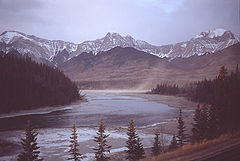| Nikanassin Formation | |
|---|---|
| Stratigraphic range: | |
 Nikanassin Formation near Brule | |
| Type | Geological formation |
| Underlies | Cadomin Formation |
| Overlies | Fernie Formation |
| Thickness | 400 meters (1,300 ft) to 0 |
| Lithology | |
| Primary | Sandstone, shale |
| Other | Coal |
| Location | |
| Coordinates | 53°17′21″N 117°52′34″W / 53.28917°N 117.87611°W |
| Region | Western Canada Sedimentary Basin |
| Country | |
| Type section | |
| Named for | Nikanassin Range |
| Named by | MacKay, 1929[1] |
The Nikanassin Formation is a stratigraphic unit of Late Jurassic (Portlandian) to Early Cretaceous (Barremian) age.[2] It is present along the western edge of the Western Canada Sedimentary Basin in western Alberta and northeastern British Columbia.[3] Its name was first proposed by D.B. Dowling in 1909 (Coal Fields South of Grand Trunk Pacific Railway, in the foothills of the Rocky Mountain, Alberta Page 140 paragraph 4 " to this it is proposed to give the name Nikanassin, from the Cree word meaning outer range" Also it is noted on the map by D.B. Dowling.(Geological Survey of Canada. Incorrect info follows: It was named by B.R. MacKay in 1929[1] for the Nikanassin Range of the front-central ranges of the Canadian Rockies (Nikanassin means "first range" in Cree[4]). Mackay did not designate a type locality for the formation, although he described outcrops near the hamlet of Brûlé, north of the Yellowhead Highway outside of Jasper National Park.[5][6]
- ^ a b Mackay, B.R., 1929a. Mountain Park Sheet, West of Fifth Meridian, Alberta; Geological Survey of Canada, "A" Series Map 208A, Scale: 1:63360 (1 Inch to 1 Mile).
- ^ Poulton, T.P., Tittemore, J. and Dolby, G. 1990. Jurassic strata of northwestern (and west-central) Alberta and northeastern British Columbia. Bulletin of Canadian Petroleum Geology 38A: 159-175.
- ^ Mossop, G.D. and Shetsen, I., (compilers), Canadian Society of Petroleum Geologists and Alberta Geological Survey (1994). "The Geological Atlas of the Western Canada Sedimentary Basin, Chapter 18: Jurassic and Lowermost Cretaceous strata of the Western Canada Sedimentary Basin". Archived from the original on 2013-03-26. Retrieved 2013-08-01.
{{cite web}}: CS1 maint: multiple names: authors list (link) - ^ Bivuac.com. "Nikanassin Range". Retrieved 2009-02-05.
- ^ Cite error: The named reference
Glasswas invoked but never defined (see the help page). - ^ Cite error: The named reference
lexiconwas invoked but never defined (see the help page).